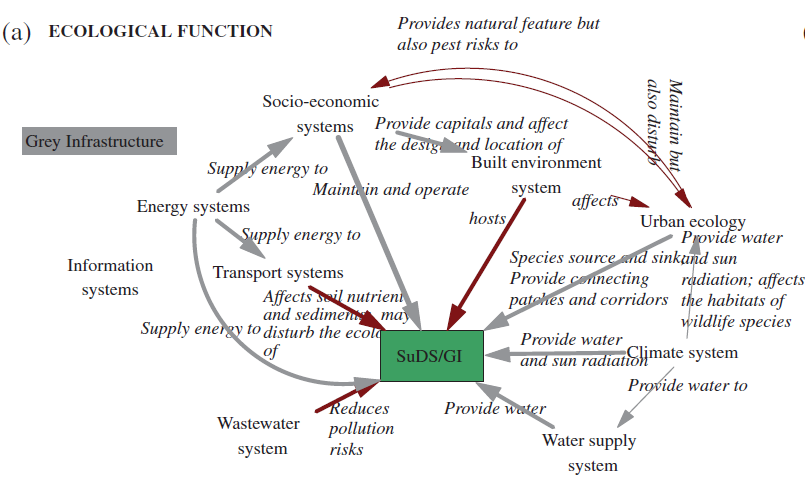
September 9, 2015, by Blue-Green team
System interactions of stormwater management using SuDS and GI
Stormwater management solutions, such as Sustainable Urban Drainage Systems (SuDS) and Green Infrastructure (GI), interact widely with the urban landscape and a series of interdependencies between different urban infrastructure (e.g. water management, energy, telecommunications and information technology) influence the success of strategies to manage urban flood risk and stormwater and potential modification of the urban fabric. Dr Lan Hoang and Dr Richard Fenner (Centre for Sustainable Development, Cambridge University) investigate these interdependencies in a new paper published in the Urban Water journal. They investigate the hydrological, ecological and built environment functions of SuDS/GI during the non-flood condition (events up to the design rainfall) and flood condition (controlled exceedance and uncontrolled exceedance) and demonstrate how SuDS/GI can modify urban functional and relational complexities. This links with their research as part of the Blue-Green Cities WP3 (Flood Risk Management Components and Interfaces). They end their paper with a discussion of the key barriers towards the effective adoption of SuDS/GI in the UK context.
The paper starts by looking at the cascading flood impacts within the urban system, e.g. impacts on critical infrastructure and social interactions/services. This leads to the recognition of urban interdependencies (separated into physical, geographical, cyber and logical interdependencies) and impact pathways, which are influenced by the level of flooding. For instance, UK flooding in 2007 and 2013-14 disrupted the road network and emergency services, led to power cuts which subsequently affected water treatment works, interrupted care provisions and caused displacement. The types of infrastructure that could be used to manage flooding is also dependent on the size of the event; from wetlands to address small (e.g. 2 yr return period) events to detention basins and subsurface storage to address larger (100 yr return period) events.
The paper then takes a detailed look at the physical interactions between urban components; first, during the non-flood condition and second, during the exceedance condition of controlled and uncontrolled surface flooding.
A key point is that under the non-flood condition, grey infrastructure continues to provide a hydrological function but offers little built environment or ecological functionality. In contrast, SuDS/GI based strategies offer hydrological, ecological and built environment functionality.
The interdependencies around the ecological function of SuDS/GI and grey infrastructure are illustrated in the diagram below (the paper contains diagrams for the other functions during flood and non-flood conditions). The paper then documents the influence of SuDS/GI on urban components, potential SuDS/GI interdependencies, the role of perception and preference in the overall impacts and the associated variation and uncertainty in impacts.

Examples of urban interdependencies for ecological functions of stormwater management (Hoang and Fenner 2015)
The next section of the paper moves away from SuDS/GI functionality and looks at the relational complexity (complexity related to humans and their different perspectives and views) and current responsibilities for stormwater infrastructure in the UK, e.g. the interdependencies between Local Authorities, Environment Agency and Water Companies in the management of SuDS/GI and grey infrastructure.
To effectively co-ordinate SuDS/GI implementation, the authors conclude that many organisational and agency partnerships need to be re-framed.
This organisational barrier is one of the three barrier types that can limit widespread implementation of SuDS/GI; others include physical barriers (e.g. physical limitations on performance) and perception/information barriers (how SuDS/GI are perceived as short-term solutions with low certainty in the reliability of their functions). A practical step to reducing organisational complexity can be through enhanced dialogue with all relevant stakeholders, such as through Learning and Action Alliances (LAAs), where stakeholders can discuss innovative and visionary strategies in an environment of trust without being bounded by institutional constraints or the need to reach a formal decision. In 2014, the Blue-Green Cities research project established a LAA in Newcastle – further information can be found on the LAA webpage.
The full paper can be downloaded from the journal’s website (Urban Water journal).
Check out the Blue-Green Cities website for more information on the project and WP3.
No comments yet, fill out a comment to be the first

Leave a Reply